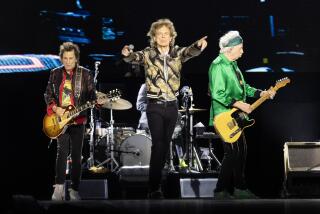Living Colour Making It in Black and White World
- Share via
One thing the members of Living Colour like is having the last laugh, and they have been having it a lot lately.
Right now, everybody in radio loves the band. And why not? After all, not only is “Vivid,” Living Colour’s debut, entering its second year on the Billboard album chart, but the band is also in the midst of a national tour with the Rolling Stones.
This, says singer Corey Glover, is quite a shift from the indifference that met Living Colour when its album was first released, about 18 months ago. “Nowadays, we’ve got a lot of radio people talking to us after the show, glad-handing us and telling us it’s a great album,” he says.
“All of a sudden it’s a great album, when before we couldn’t get program director one to come down to a show, let alone tell us it was a good album.”
Why did it take so long for radio to develop an interest in Living Colour? To a certain extent, simply being a new band made it harder for them to get a fair hearing from programmers than if the group had a history of successes behind it. But it didn’t exactly help matters that the members of Living Colour were African-Americans playing hard rock, a style that the industry perceived as the domain of white musicians.
Obviously, the listeners didn’t feel that way--how else could “Vivid” have sold more than a million copies? But Glover thinks that such assumptions are typical of the way radio and TV outlets view their audiences.
“Whereas radio and television give a narrow-minded view, almost like a person with blinders on where there’s no peripheral vision, we give (a much broader perspective). I mean, my taste is not all rap music, for example, or all heavy metal--my experience is that of a whole lot of different types of music.
“We figured everybody else felt that way, too. So if that’s the case, then why not give a show or make music that does that?”
That’s why a Living Colour stage show is as likely to include hip hop-style audience chants as Led Zeppelin-style power riffs; as far as this band is concerned, it’s all rock ‘n’ roll. Says Glover: “We take elements of all kinds of music-- which is what rock is all about, anyway--and turn it into a completely different animal. Rock ‘n’ roll is a polyglot of different things, like rhythm and blues and jazz music and the blues themselves, and it became a totally different animal with the advent of youth culture.
“We just keep that spirit alive, taking all different types of music, and different experiences that people can relate to, and incorporating them under the heading of rock and roll. It’s easy for people to relate to, and I think that’s where our success and our acceptance have come from.”
Why, then, hadn’t that thought occurred to anyone else in the music industry?
“Money,” Glover says. “A lot of it has to do with demographics and money. If you do something that’s too broadly based, you’re going to miss your core audience, your core record-buyer, and you won’t get your point across. That’s their thinking, and it’s a ridiculous notion. If you feel differently, why not express it differently?”
On the whole, Glover is optimistic about the prospects for change. For starters, it’s hard not to be encouraged by the fact that MTV accepted Living Colour with the same enthusiasm it bestowed on last year’s other big new acts, Guns N’ Roses and Tracy Chapman. And the enthusiastic reception the band has been getting on the Rolling Stones tour has also provided a sizable ego boost.
But he thinks that there is still more to be done. “I would really like to see changes in the music industry, and in the performing arts themselves,” he says, adding that he can’t understand why the industry seems to expect Michael Jackson-ish virtuosity from any performer who dares to exhibit more than one talent.
“Why can’t anybody be like a singer and a dancer, be average at both and do really well?” he asks.
More to Read
The biggest entertainment stories
Get our big stories about Hollywood, film, television, music, arts, culture and more right in your inbox as soon as they publish.
You may occasionally receive promotional content from the Los Angeles Times.










